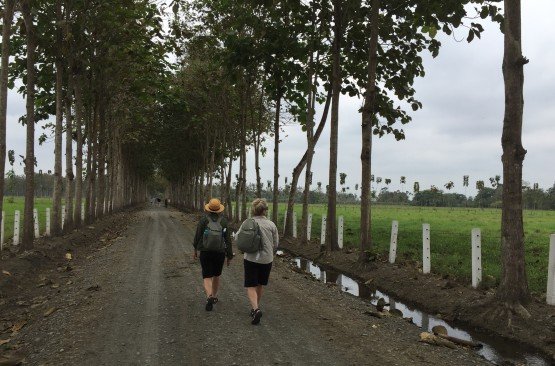 Yesterday at the Duran station outside Guayaquil we boarded a bright red train pulled by a steam engine, the beginning of a four-day exploration of Ecuador via Tren Crucero.
Yesterday at the Duran station outside Guayaquil we boarded a bright red train pulled by a steam engine, the beginning of a four-day exploration of Ecuador via Tren Crucero.
Darlene, Deb and I were assigned seats in Car 1, a jewel of a space featuring friendly little face sculptures smiling at us over the windows, decorated with swirling design around them in gold paint. The train moved very slowly, and I was distracted for the first ride by an enlightening chat with my table mate, a woman from Germany traveling in Ecuador for the month. Her pearl, offered at no extra cost, was her utter freedom from Internet entanglements, even though she has an apparently responsible position with a unit of Fiat, selling trucks in Munich. She does not check text or email on weekends or when she is in Ecuador for a month. People don’t expect her to, because she has been consistent in her habits online. I was inspired to try yet again to maintain some sort of balance to my Internet habit when we return to Boston.
We sat in comfortable upholstered chairs with curved wooden legs and arms, looking at the countryside through huge windows framed by red curtains. Coffee and drinks were served, along with snacks. I never made it to the elegant lounge car at the back of the train, where there were wicker couches and a platform at the back where you could have made speeches like Harry Truman on his whistlestop campaign tour in 1948.
At Yaguachi, 22 kilometers from Duran, we got off the train and watched the steam engine be replaced by a diesel electric locomotive, also bright red. It was hot and humid at 15 meters elevation. Back on the train, it was a relief to return to air conditioned comfort and a tasty treat with plaintains.
I love the train, a project for tourists of the Ecuadorian government, and the enthusiasm of the staff and guides. But I have to warn fellow train buffs that this is not your Orient Express fantasy featuring a snug berth in a sleeper car. Your bags go from hotel to hotel by bus, and sleeping is not done to the rocking of the train and the clickety clack of the track. Ecuador is making the most of a train line that at one time connected Guayaquil to Quito but is now restored only in limited stretches.
That meant we switched from our bright red train to bright blue buses in order to travel to lunch at the Hacienda La Danesa in Naranjito. The estate was purchased 150 years ago by a Danish immigrant whose great-grandson met us at the entrance with a warm welcome. He earned his undergraduate degree at the University of Louisiana in Baton Rouge and a master’s degree in tourism at Melborne. I asked at lunch if he has lots of ideas for growing the hacienda’s tourism business that older family members are nervous about, and he said oh yes. He’s on track though, with providing excellent accommodations for day travelers like the 50 of us who arrived for lunch and demonstrations of chocolate making and cow milking.
I am typing in the near dark in a corner of the dining area while the staff prepares breakfast at D’Franco Hosteria in Bucay. I hear rain outside and the banging of pots in the kitchen. We leave early by bus to be reunited with our red train in our assigned seats. Today’s track will include the famous Devil’s Nose climb up a steep slope in the Andes.


